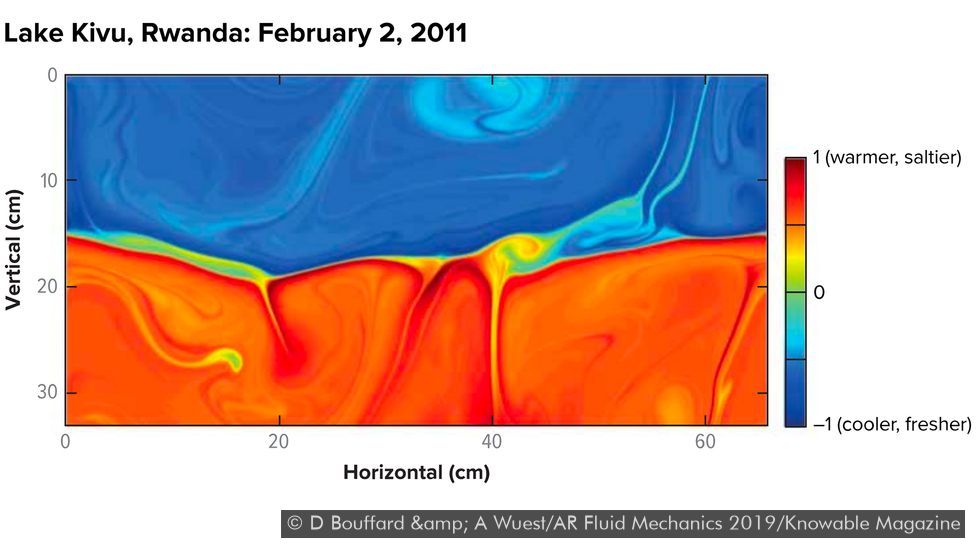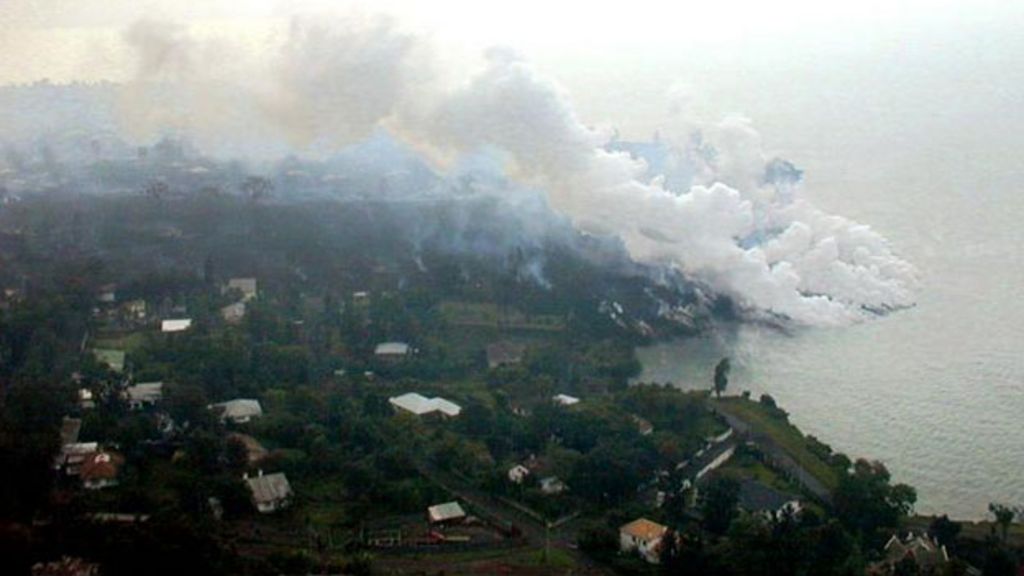

Posted on 10/18/2020 5:50:17 PM PDT by Roman_War_Criminal
In central Africa is a deep lake that has a dangerous propensity to explode – but tapping it as a source of energy could help avert disaster.
Lake Kivu is one of Africa’s strangest bodies of water. An unusual set of properties make it an intriguing subject for scientists, as well as a potential source of both peril and prosperity for the millions of people living nearby.
Kivu doesn’t behave like most deep lakes. Typically, when water at the surface of a lake is cooled – by winter air temperatures or rivers carrying spring snowmelt, for example – that cold, dense water sinks, and warmer, less dense water rises up from deeper in the lake. This process, known as convection, generally keeps the surfaces of deep lakes warmer than their depths.
But at Lake Kivu, circumstances have conspired to block this mixing, giving the lake unexpected qualities – and surprising consequences.
Straddling the border between Rwanda and the Democratic Republic of the Congo, Kivu is one of a string of lakes lining the East African Rift Valley where the African continent is being slowly pulled apart by tectonic forces.
The resulting stresses thin the Earth’s crust and trigger volcanic activity, creating hot springs below Kivu that feed hot water, carbon dioxide and methane into the lake’s bottom layers.
Microorganisms use some of the CO2, as well as organic matter sinking from above, to create energy, producing additional methane as a by-product.
These gases would ordinarily bubble out of the water, but Kivu’s great depth – more than 460 metres (1,500ft) at its deepest point – creates so much pressure that they remain dissolved.
This mixture of water and dissolved gases is denser than water alone, which discourages it from rising.
The deeper water is also saltier due to sediment raining down from the upper layers of the lake and from minerals in the hot springs, which further increases the density.
The result, says limnologist Sergei Katsev of the University of Minnesota Duluth, is a lake with several distinct layers of water of sharply different densities, with only thin transition layers between.
The layers can be separated roughly into two regions: one of less-dense surface water above a depth of about 60m (200ft) and, below that, a region of dense saline water that is itself further stratified, says Alfred Wüest, an aquatic physicist at the Swiss Federal Institute of Technology in Lausanne.
Here is mixing within each layer, but they don’t interact with each other. “Just think of the entire water mass sitting there for thousands of years and doing nothing,” says Wüest.
But Lake Kivu is more than just a scientific curiosity. Its unusual stratification and the CO2 and methane trapped in its deeper layers have researchers worried that it could be a disaster waiting to happen.
Lurking danger
About 1,400 miles (2,250km) north-west of Kivu, a crater lake in Cameroon known as Lake Nyos similarly accumulates and traps large amounts of dissolved gas – in this case CO2 – from a volcanic vent at the bottom of the lake.
On 21 August 1986, the lethal potential of that gas reservoir was made tragically evident. Possibly due to a landslide, a large amount of water was suddenly displaced, causing the dissolved CO2 to mix rapidly with upper layers of the lake and release into the air. A large, deadly cloud of the gas asphyxiated an estimated 1,800 people in nearby villages.
Events like this are called limnic eruptions, and scientists fear that Kivu may be ripe for a similar, even deadlier event.
Nyos is a relatively small lake, measuring a little more than a mile long (1.6km), just under a mile wide and less than 210m (700ft) deep.
Kivu is 55 miles (89km) long, 30 miles (48km) across at its widest point and more than twice as deep as Nyos. Because of its size, Katsev says, Kivu “has the potential for a major, catastrophic limnic eruption where many cubic miles of gas would be released.”
About 14,000 people lived near Nyos at the time of the eruption. More than two million live in the vicinity of Lake Kivu today, including roughly one million residents of the city of Bukavu, in the Democratic Republic of the Congo. If Kivu were to erupt, says limnologist Sally MacIntyre of the University of California, Santa Barbara, “it would be completely catastrophic.”
Not just a theoretical concern Scientists have found what may be evidence of at least one previous limnic eruption at Kivu that likely occurred between 3,500 and 5,000 years ago, and possibly several more recent ones.
Sediment cores taken from the bottom of the lake have revealed features known as brown layers that are unlike the surrounding sediments. These sediment bands are “very unusual, organic-rich layers,” Katsev says, that may be the result of eruptions.
And they also want to search for oil at the bottom of the lake. Crazy, no?
What are limnic eruptions? Limnic eruptions can occur for two reasons.
If the water becomes completely saturated with dissolved gases, any additional CO2 or methane injected into the lake will be forced to bubble out of solution, rise and be released into the air.
Eruptions can also be caused when something forces the deep water with its dissolved gases to mix with the layers above, reducing the pressure on the gases and allowing them to quickly come out of solution and escape, similar to the effect of shaking a can of soda and then opening it.
While a landslide of the scale suspected in the Nyos eruption might not cause enough mixing at Kivu, due to the lake’s size and depth, there are several other possible triggers. Kivu is in a seismically active area, so an earthquake could generate waves in the lake that would mix the layers enough to release the trapped gases. Climate is also a potential culprit.
At least one past eruption discovered in the sediment record appears to have been caused by drought that evaporated enough water from the top of the lake to reduce the pressure at the lower levels and release the dissolved gases.
Lowered water levels during dry periods could also leave Kivu more vulnerable to disruption from particularly heavy rain. They could flush enough built-up sediment from the many streams feeding into the lake to cause the layers to mix, MacIntyre says.
Another possible trigger is volcanic activity under the lake or from surrounding volcanoes, but scientists think the risk of that is low.
A 2002 eruption of nearby Mount Nyiragongo didn’t bring in enough material to disrupt Kivu’s bottom layers. And modelling studies have shown that volcanism below the lake wouldn’t cause a big enough disruption either, MacIntyre says.
Whatever the cause of an eruption, the effect would be the same. Accumulated gases would be released from their dissolved state, creating dense clouds of CO2 and methane that, as happened with the CO2 at Nyos, could displace oxygen and lead to asphyxiation.
And if enough methane were released into the air at Kivu, there is the additional risk that it could ignite.
Katsev says that the lake is monitored regularly for signs of upticks in gas concentration, so a sudden upwelling “will not catch us by surprise”. More than a dozen seismic stations measure the activity near the lake in real time as well.
And in 2001, an effort began to reduce the risk of another disaster at Nyos by siphoning water from the bottom of the lake through a pipe to the surface, where the CO2 is released into the air at a safe rate. Similar efforts are underway at Kivu.
Mining the depths As gas concentrations rise in Kivu’s depths, so does the risk. Wüest and colleagues found that from 1974 to 2004 the concentration of CO2 increased by 10%. But the bigger concern at Kivu is the methane concentration, which rose 15-20% during the same period.
There may be a way to turn Kivu’s risk into reward, though. The same gas that could fuel a deadly natural disaster has potential as an energy source for the region.
In 2008, Rwanda launched a pilot programme taking methane from the lake to burn as a natural gas and last year signed a contract to export bottled methane. A much larger methane extraction programme, called KivuWatt, came online in 2015.
The projects pump water from the deep layers of the lake, and as the pressure is reduced on that water, the gases are released. The methane is extracted to be used as fuel, and the CO2 is pumped back down to the bottom of the lake. “They take this gas, ship it via pipeline onshore and burn it the way you would burn fossil fuels to generate electricity,” Katsev says.
For the people living in the lake’s vicinity, this could become an important source of energy. Once KivuWatt is fully online, the 100 megawatts of power produced by the project could make a significant difference for Rwanda, a developing country where only 35% of the population has access to electricity.
Harvesting the Lake Kivu’s gases might help to reduce the risk from eruption, though it won’t eliminate it. Still, for a lake with that much danger lurking below, any reduction in risk is a valuable step.


“Lake Nyos similarly accumulates and traps large amounts of dissolved gas..
On 21 August 1986, the lethal potential of that gas reservoir was made tragically evident...A large, deadly cloud of the gas asphyxiated an estimated 1,800 people in nearby villages.
Here’s a vid on how they fixed the problem:
https://www.youtube.com/watch?v=zEs6j0MGTgk&feature=emb_logo
With Lake Kivu they want to try to harness for power generation.
I remember that incident.
It took them a while to figure out what happened to kill all those people from no apparent cause. They just died where they were with no signs of violence or physical attack of any kind.
Why are they pumping the CO2 back into the lake? It would seem like they’re kicking the asphyxiation scenario can, down the road for others to deal with. It would seem like a controlled release of the CO2 from the lake is as important in risk reduction as is the methane extraction.
I know, climate change places these two million people at risk, by it’s hysterical claims that CO2 is harmful to the earth’s climate. What idiots.
Follow the money
The return of pressurized CO2 to the deep layer of the lake is for the sake of safety and is not done to keep it out of the atmosphere.
The same happens with the icing in antartica.
Hence the reason why it is warming which precedes CO2 release, and not CO2 that causes global warming
there has never been correlation between CO2 release in causing warming, but the reverse, yes.
Yes, a far more damaging natural disaster than human polution.
So the question is, why do they want to pump back CO2 at the bottom?
That is dangerous
Ah yes, a Meromitic lake plagued by limnic eruptions each 1,000 years or so.
I remember this in the news back then. Not good!
I too remember the Nyos disaster. I have some vague recollection that the lake was in a narrow ravine area, so the gas went fairly high up. The picture here of lake Kivu shows the ground rising gradually over a wide area. Are there differences in the two topographies that would reduce the dangers of mass death?
The 'burp' from Nyos happened at night, if memory serves, and the survivors were those who slept on their roofs due to the heat. They woke to total silence, all the farm animals had also died.
Disclaimer: Opinions posted on Free Republic are those of the individual posters and do not necessarily represent the opinion of Free Republic or its management. All materials posted herein are protected by copyright law and the exemption for fair use of copyrighted works.